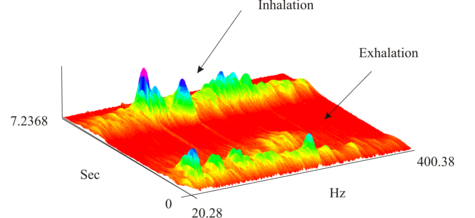Respiratory airflow sensor

Asthma and COPD are common illnesses that in many patients involve recurrent acute severe inflammatory exacerbations. These exacerbations typically build up in severity over several days but by the time a patient realizes that he's getting into trouble it may be too late to avoid an ER or hospital admission. When these patients get this sick they need treatments with much greater risks of side effects than if the episode was recognized and treated early, and they are also at risk for permanent lung injury and sometimes death.
The ideal time to treat these episodes is before the patients are aware that they're having them. Home peak flow meters used at home twice every day and also at times of symptoms improve early recognition, but what they measure isn't either the most sensitive or the earliest test to use for early recognition. Accurate tracking with these devices depend on the patient blowing as hard as he can every time, which is often not reliable at home.
Dr. Coifman and industrial chemist Dr. Charles Forbes developed a light weight, simple and stable sensor of respiratory airflow that matches the performance of the bulky, costly, much less stable and less portable sensors used in present day pulmonary function measuring equipment. With a grant from the National Science Foundation we were able to further improve its performance to a level that makes it possible to design devices for home tracking of early signs of exacerbations which are more sensitive than even standard office pulmonary function and which do not depend on effort by the patient. We have a method of automated data analysis that can alert both patients and their treating physicians any time the patient begins to drift out of what is called "Statistical Process Control." If this most sensitive early warning test is combined with this most sensitive method to identify when test results begin to drift out of control, we expect to be able to identify almost all exacerbations in at-risk patients early enough for early and simpler treatment to keep them out of hospitals, keep them alive and free of complications of treatment, and significantly reduce their total cost of health care.
The company we formed is called Feather Sensors and its website is www.feathersensors.com. We're looking for both research grants and outside investment to build and test prototype devices for initial clinical trials.